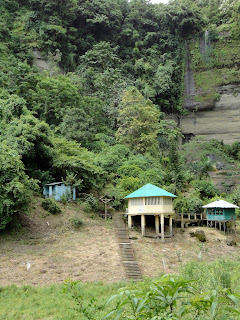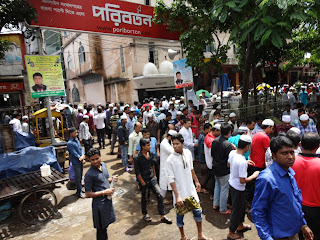08/03/13
One
of the most challenging parts of living in South Asia (for me) is figuring out
how to talk to different classes and roles of people. I recently read a book
set in 16th century England, and it described the relationship
between master and servant as a strange mixture of familiarity and
invisibility. It seemed like a good description of the relationship I see
around me between servant class and middle/upper class here. It is hard for an
American to understand the role of servants. Most of us are not used to having
people who cook our meals, clean our homes, drive or cycle rickshaw us from
place to place, do our grocery shopping, run our errands, wash our clothes.
This list could go on and on, I think.
 |
| This woman had cooked us rice cakes in her village in the Hill Tracts. They were delicious. Her generosity in sharing her food and her home was wonderful. I don't even remember her name. |
The Bangla language even has the
idea of varying degrees of respect built into it; there are three different
ways to speak in second person: a formal, an informal, and a familiar. The
formal is used for anyone older or worthy of respect for some other reason
(perhaps they hold a place of political consequence, for instance). I also use
the formal when talking to all service employees inside and outside my home.
Many Bangladeshis do as well, though it is not uncommon to hear service workers
addressed with the informal. The informal is used for people you are close with
or who you consider your equals. Friends, lovers, less formal relations with
relatives, classmates and peers can all be addressed with the informal. The
familiar is used to speak to children (sometimes) and is basically an insult
when speaking to anyone else.
Anyway, these proscribed roles have
always been noticeable to me as a part of South Asian cultures, but they became
particularly sticky around the concept of Eid bakshish. Eid is the biggest
holiday of the year in Bangladesh. Shopping is a nightmare because everyone is
out until the last minute looking for the perfect gifts (and businesses mark up
their products accordingly). Beautiful strings of lights in every color of the
rainbow adorn buildings. People buy a nice outfit (or a few nice outfits) to
wear out visiting family and friends. On the day of Eid, most businesses shut
down and people leave the city in droves to go back to their home villages to
spend the three(ish) day holiday with their families.
 |
| This is a village like many of the ones people return to over the holidays. |
In order to afford to get to their
villages and to bring the expected presents for their family members with them,
many members of the servant class receive an Eid bakshish (read Christmas
bonus). When you have as many servants in as many roles as we do, this bakshish
adds up. In our dormitory alone, we needed bakshish for two cleaning women, one
laundry lady, a front door guard, a building caretaker, a household caretaker,
two cooks, and a driver. Besides these people, many rickshaw pullers, door
guards, and beggars will ask for Eid bakshish in the week leading up to the
holiday.
This means that I suddenly find
myself hyper-aware of how dependent these people are on the consideration and
generosity of those for whom they work. It is a precarious way of life, and I
cannot begin to imagine how they view their relationships to me and their other
employers. These relationships are personal enough to involve friendly
conversations or even genuine socializing, but it does not seem possible (to
me, at least) that anyone ever forgets the power dynamics underlying them. When
my money is the only thing guaranteeing that the caretaker can go home and see
the wife he has not seen in five months, how can any of us forget?
These relationships certainly exist
in the U.S. as well, but we bury them deeper and avoid talking about them when
we can. Here, it is all on the surface. And this is what brings me back to my
original concern about how to talk to people. Because I am relatively well off
by Bangladeshi standards, I have more of the power in these relationships.
However, because I do not have the depth of cultural knowledge and comfort of
someone who grew up here, I am always hesitant to overstep my bounds by being
too personal. I do not want anyone to think they HAVE to talk to me/socialize
with me/help me practice my Bangla simply because I control some portion of
their income. I keep the relationship more formal than it probably needs to be
because I am worried about respect. And of course, because I do this
purposefully, I worry that I am missing out on the potential for interesting
friendships and social interactions. At the end of the day, I’m not sure my
solution is the best one possible.
 |
| Some cool graffiti near Dhaka University. |








































